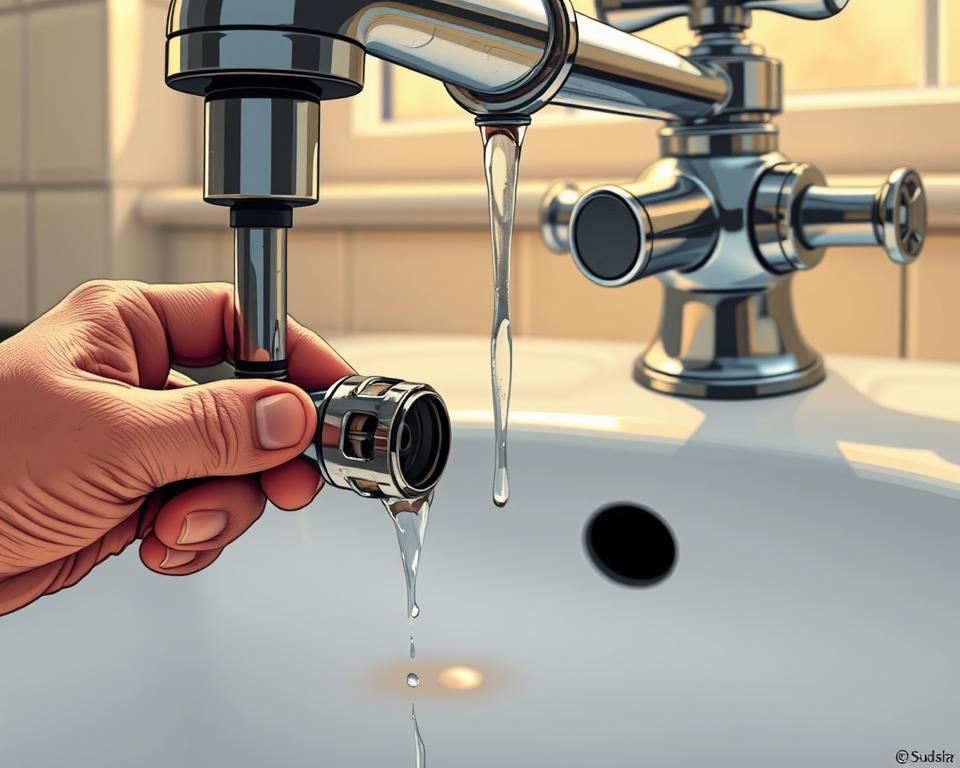DIY Guide: How to Replace Faucet Valve Seats
Did you know a leaky fixture can waste over 3,000 gallons of water a year? It’s enough to top off a small pool! Fixing worn-out components saves money and conserves water—no plumbing experience needed.
This guide makes repairs simple. Grab supplies from Installation Parts Supply and end leaks in no time. Dodge high plumber bills and achieve a drip-free home with faucet seat.
Adhere to these instructions for an easy replacement. Quality materials ensure lasting results, and you’ll gain confidence tackling future projects.
Essential Insights
- Drips spike water costs—simple repairs save both water and money.
- Tackling it yourself cuts out plumber fees.
- Durable components from reliable sources last longer.
- User-friendly steps plus simple tools make it easy.
- Routine care prolongs fixture lifespan.

The Importance of Replacing Faucet Valve Seats
A small drip might seem harmless, but it can lead to big problems. Worn components in your plumbing waste water, hike up bills, and risk damage to your home. Fixing issues early saves money and keeps your fixtures running smoothly.
Detecting a Worn Valve Seat
Be on the lookout for:
- Water drips despite a snug handle.
- Inconsistent flow, like spurts or weak pressure.
- Visible rust or pitting on metal parts.
Kitchen drips hinder cooking and leave unsightly marks. Early service stops headaches down the road.
The Mechanics of Valve Seat Wear
Limescale and friction gradually erode metal parts. This creates gaps where water escapes. Left unchecked, valve seat corrosion can ruin the entire fixture.
Trust Installation Parts Supply for durable replacements. Their parts resist buildup, ensuring a tight seal and lasting performance.
Prompt faucet leak fixes safeguard your home and save thousands of gallons.
What You Need
Good tools plus quality parts deliver lasting repairs. Whether you’re tackling a minor drip or a stubborn leak, the right supplies save time and hassle. Collect the following tools and parts:
Must-Have Tools for Valve Seat Replacement
A basic plumbing tools list includes:
- Adjustable wrench for nuts and fittings.
- Seat extractor wrench—to pull old seats.
- Phillips and flat-head screwdrivers for disassembly.
- Pliers: Grips small components securely.
Use a seat-grinding bit to clean badly corroded seats. Stock a faucet repair kit that includes seats, washers, O-rings.
Buying Parts
Don’t settle for disposable components. Installation Parts Supply offers durable, compatible components nationwide. Their repair kits bundle all necessary parts plus guidance.
| Must-Haves | Optional (For Advanced Jobs) |
|---|---|
| Adjustable wrench | Seat grinding tool |
| Seat wrench | Torch (for stubborn parts) |
| Repair kit | Tubing cutter |
Good tools and parts save repeated trips. You’ll avoid repeat repairs and enjoy a drip-free home for years.
Step-by-Step Faucet Valve Seat Replacement
A straightforward DIY fix that halts water loss. Whether you’re a beginner or a seasoned DIYer, these steps ensure a smooth process. Gather your tools and let’s get started.
Step 1: Cut Water & Take Apart
Find and close the shutoff valves beneath your sink. Run the tap briefly to clear water out. Use a screwdriver to remove the handle, then unscrew the retaining nut with an adjustable wrench.
Pro Tip: Label parts with tape to simplify reassembly. Installation Parts Supply’s anti-corrosion nuts extend service life.
Step 2: Extract the Worn Seat
Check for buildup and wear. Insert your seat tool into the old seat and twist CCW. If stuck, spray penetrating oil and let it soak for 10 minutes.
| Common Challenges | Fixes |
|---|---|
| Seized seat | Use heat (carefully) or a locking plier |
| Damaged threads | Swap out the housing assembly |
Step 3: Insert Replacement Seat
Brush off debris from the threads. Position the new *replace valve seat* from *Installation Parts Supply* and tighten by hand. Tighten carefully to avoid stripping.
Step 4: Reassemble and Test for Leaks
Reassemble parts in the opposite sequence. Restore water flow slowly. Inspect for drips and gently tighten as required. Nailing this DIY faucet repair keeps your bills low!
Wrapping It Up
Enjoy peace of mind with sturdy, leak-free plumbing. Addressing issues promptly conserves water and money.
Armed with these instructions, you’ll repair like a pro. Count on Installation Parts Supply for parts that withstand wear.
Incorporate these maintenance habits: yearly washer checks and tightening loose parts. Small efforts now avoid big repairs later.
Ready to put your skills to work? Grab your tools, follow the steps, and enjoy a drip-free home today!
